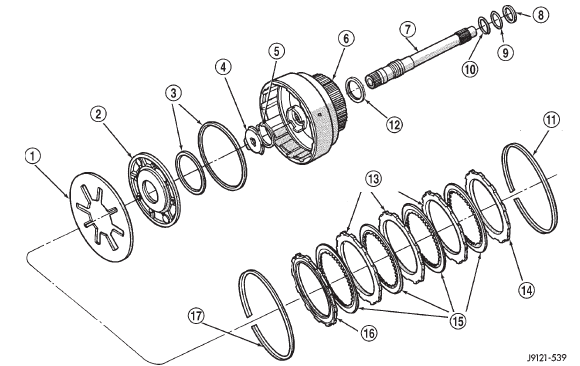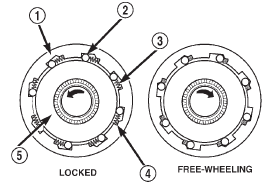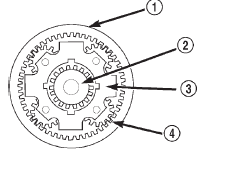Jeep Cherokee (XJ): Rear clutch. Overrunning clutch. Planetary gearset
DESCRIPTION The rear clutch assembly (Fig. 44) is composed of
the rear clutch retainer, pressure plate, three clutch
plates, four driving discs, piston, Belleville spring,
and snap rings. The Belleville spring acts as a lever
to multiply the force applied on to it by the apply piston.
The increased apply force on the rear clutch
pack, in comparison to the front clutch pack, is
needed to hold against the greater torque load
imposed onto the rear pack. The rear clutch is
directly behind the front clutch and is considered a
driving component.
NOTE: The number of discs and plates may vary
with each engine and vehicle combination. OPERATION To apply the clutch, pressure is applied between
the clutch retainer and piston. The fluid pressure is
provided by the oil pump, transferred through the
control valves and passageways, and enters the
clutch through the hub of the reaction shaft support.
With pressure applied between the clutch retainer
and piston, the piston moves away from the clutch
retainer and compresses the clutch pack. This action
applies the clutch pack, allowing torque to flow
through the input shaft into the driving discs, and
into the clutch plates and pressure plate that are
lugged to the clutch retainer. The waved snap ring is
used to cushion the application of the clutch pack. In
some transmissions, the snap ring is selective and
used to adjust clutch pack clearance.
1 - PISTON SPRING When pressure is released from the piston, the
spring returns the piston to its fully released position
and disengages the clutch. The release spring also
helps to cushion the application of the clutch assembly.
When the clutch is in the process of being
released by the release spring, fluid flows through a
vent and one-way ball-check-valve located in the
clutch retainer. The check-valve is needed to eliminate
the possibility of plate drag caused by centrifugal
force acting on the residual fluid trapped in the
clutch piston retainer. DESCRIPTION The overrunning clutch (Fig. 45) consists of an
inner race, an outer race (or cam), rollers and
springs, and the spring retainer. The number of rollers
and springs depends on what transmission and
which overrunning clutch is being dealt with.
1 - OUTER RACE (CAM) OPERATION As the inner race is rotated in a clockwise direction
(as viewed from the front of the transmission), the
race causes the rollers to roll toward the springs,
causing them to compress against their retainer. The
compression of the springs increases the clearance
between the rollers and cam. This increased clearance
between the rollers and cam results in a freewheeling
condition. When the inner race attempts to
rotate counterclockwise, the action causes the rollers
to roll in the same direction as the race, aided by the
pushing of the springs. As the rollers try to move in
the same direction as the inner race, they are
wedged between the inner and outer races due to the
design of the cam. In this condition, the clutch is
locked and acts as one unit. DESCRIPTION The planetary gearsets (Fig. 46) are designated as
the front and rear planetary gear assemblies and
located in such order. A simple planetary gearset consists
of three main members:
1 - ANNULUS GEAR NOTE: The number of pinion gears does not affect
the gear ratio, only the duty rating. OPERATION With any given planetary gearset, several conditions
must be met for power to be able to flow: NOTE: Gear ratios are dependent on the number of
teeth on the annulus and sun gears.Rear clutch

Fig. 44 Rear Clutch
2 - REAR CLUTCH PISTON
3 - CLUTCH PISTON SEALS
4 - OUTPUT SHAFT THRUST WASHER (METAL)
5 - INPUT SHAFT SNAP RING
6 - REAR CLUTCH RETAINER
7 - INPUT SHAFT
8 - REAR CLUTCH THRUST WASHER (FIBER)
9 - SHAFT FRONT SEAL RING (TEFLON)
10 - SHAFT REAR SEAL RING (METAL)
11 - CLUTCH PACK SNAP RING (SELECTIVE)
12 - RETAINER SEAL RING
13 - CLUTCH PLATES (3)
14 - TOP PRESSURE PLATE
15 - CLUTCH DISCS (4)
16 - BOTTOM PRESSURE PLATE
17 - WAVE SPRINGOverrunning clutch

Fig. 45 Overrunning Clutch
2 - ROLLER
3 - SPRING
4 - SPRING RETAINER
5 - INNER RACE (HUB)Planetary gearset

Fig. 46 Planetary Gearset
2 - SUN GEAR
3 - PLANET CARRIER
4 - PLANET PINIONS (4)
 Accumulator. Pistons. Front clutch
Accumulator. Pistons. Front clutch
Other materials:
Before You Begin Programming HomeLink. Programming A Rolling Code. Programming A Non-Rolling Code
Before You Begin Programming HomeLink
Ensure your vehicle is parked outside of the garage
before you begin programming.
For more efficient programming and accurate transmission
of the radio-frequency signal it is recommended that
a new battery be placed in the hand-held transmitter of
the dev ...

